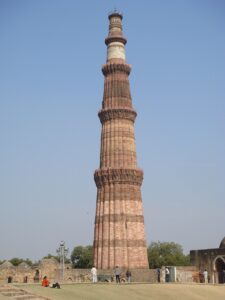Qutub Minar

Qutub Minar is one of the most iconic examples of Indo-Islamic architecture in India. Located in Delhi, this towering minaret is a UNESCO World Heritage Site and stands as a testament to the architectural ingenuity of the early medieval period in India.
Architectural Features and Construction:
- Construction and Dimensions: The Qutub Minar was commissioned by Qutb-ud-din Aibak in 1192 and completed by his successors, primarily by Iltutmish and Firoz Shah Tughlaq. It stands at a height of approximately 73 meters (240 feet) and has five distinct stories, each marked by a projecting balcony.
- Architectural Style: The minar is a classic example of Indo-Islamic architecture, blending Persian, Afghan, and local Indian styles. It features intricate carvings, fluted columns, and detailed inscriptions from the Quran.
- Historical Significance: Qutub Minar symbolizes the beginning of Muslim rule in India and marks the victory of Muhammad Ghori over Prithviraj Chauhan. It also served as a watchtower for defense purposes and a minaret for the muezzin to call the faithful to prayer.
- Cultural Impact: The Qutub Minar complex is a significant historical site, encompassing various ancient structures like the Quwwat-ul-Islam Mosque, Alai Darwaza, and the Iron Pillar, which attract scholars and tourists worldwide.
Innovations and Engineering Techniques:
- Engineering Techniques: The construction of Qutub Minar involved advanced engineering techniques of the time. The minar’s tapering design, with the diameter reducing from 14.3 meters at the base to 2.7 meters at the top, helped in maintaining stability.
- Use of Materials: The minar was built using red sandstone and marble, incorporating both durable materials and artistic elegance. The use of these materials allowed for the intricate detailing seen in the structure’s carvings and inscriptions.
- Structural Design: The minar’s fluted cylindrical shafts, alternating balconies, and supportive brackets (muqarnas) exhibit a high level of craftsmanship and attention to detail. Each story is adorned with intricate arabesques and geometric patterns.
- Integration of Earlier Structures: The Qutub Minar complex includes remnants of earlier Jain and Hindu temples, which were either repurposed or incorporated into the new Islamic architectural framework. This integration highlights the syncretic nature of early Indo-Islamic architecture.
Trivia and Lesser-Known Facts:
- The construction of the Qutub Minar took several decades and was completed by three different rulers: Qutb-ud-din Aibak, Iltutmish, and Firoz Shah Tughlaq.
- The Iron Pillar in the Qutub Minar complex predates the minar by several centuries and is known for its rust-resistant composition, baffling metallurgists to this day.
- The Qutub Minar has survived several earthquakes and was restored by different rulers, including Sikandar Lodi and the British.
- The minar’s construction was inspired by the Minaret of Jam in Afghanistan, reflecting the influence of Central Asian architectural styles on Indian monuments.